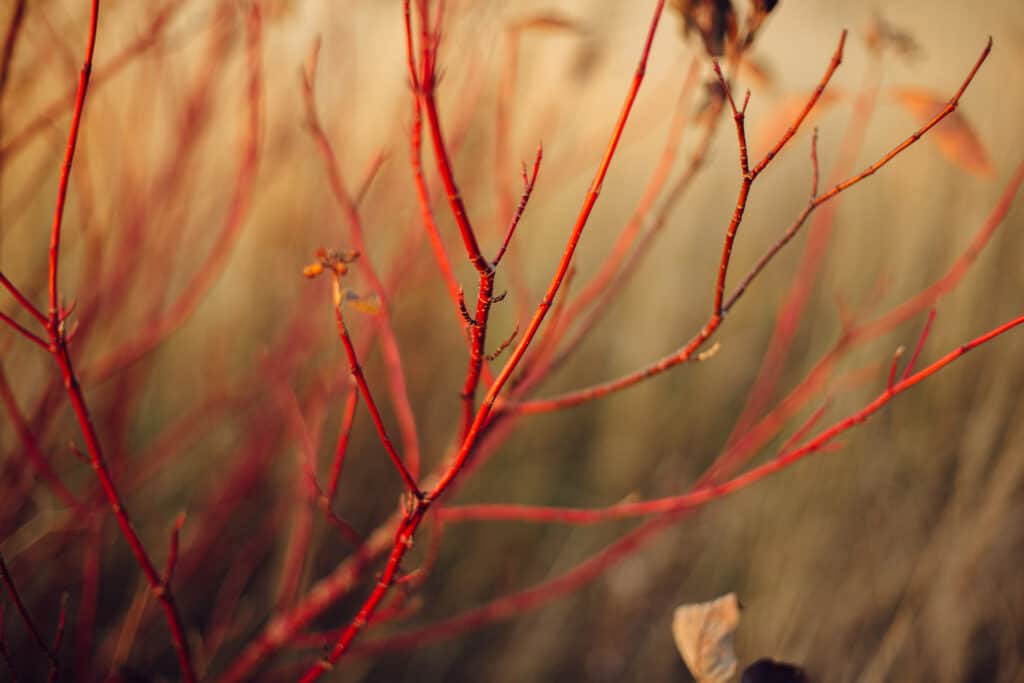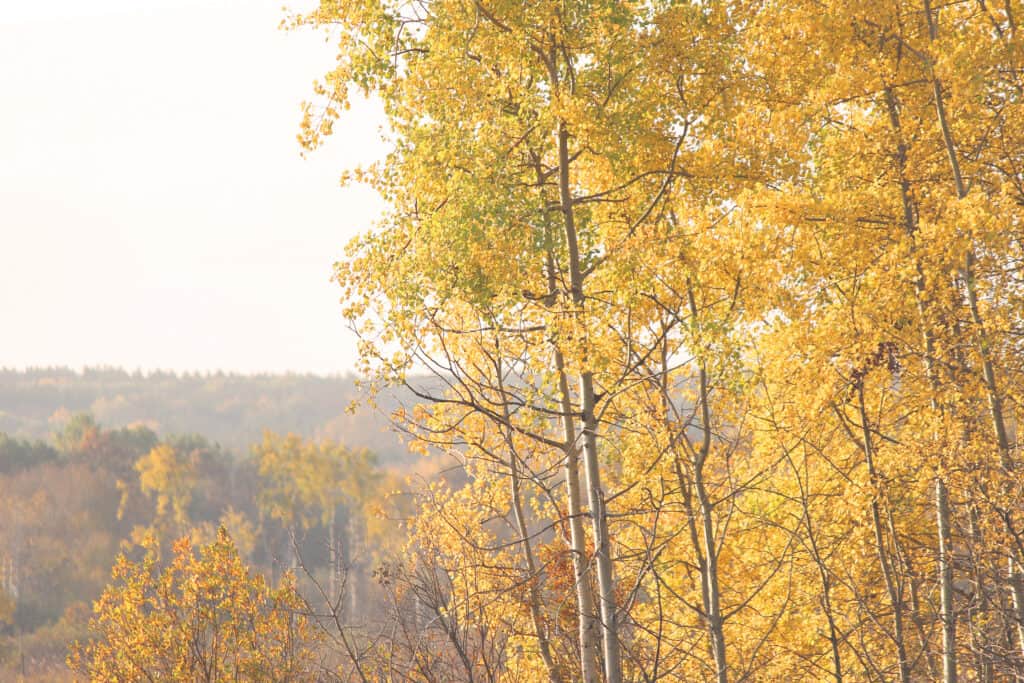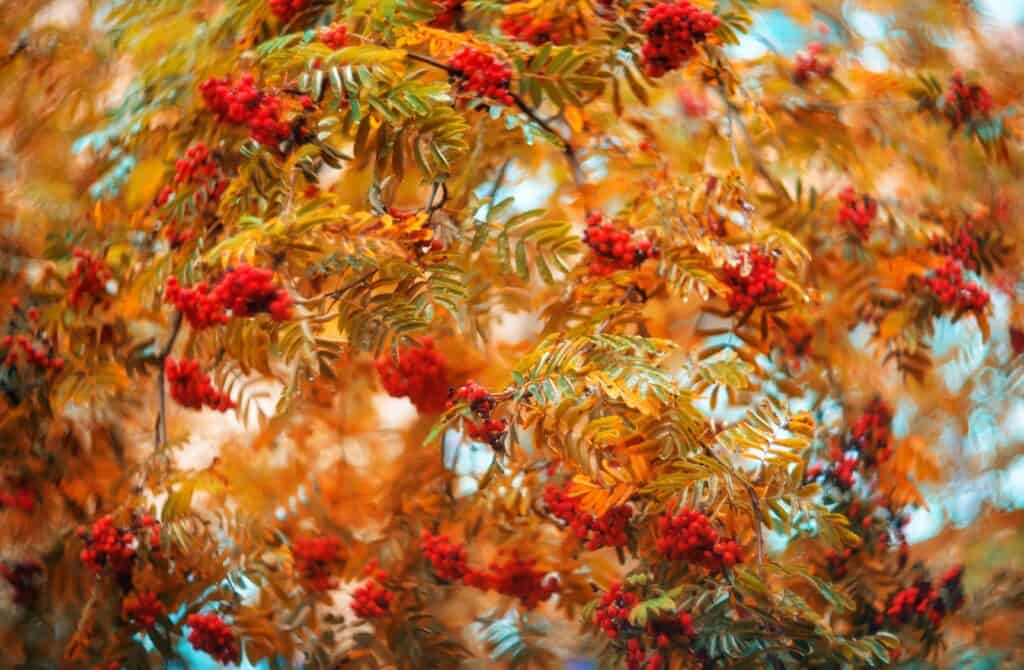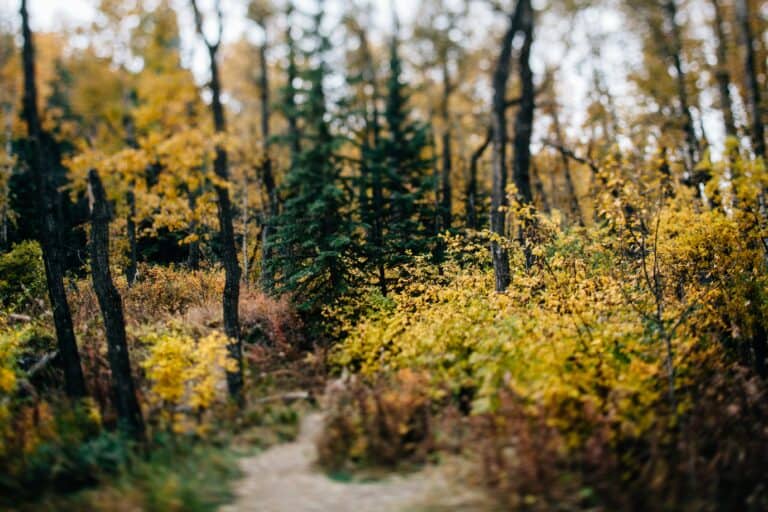We’ve had the most gorgeous fall this year. It’s pretty rare for this area to not have a solid hard freeze or snow (or intense winds) before late October, and we’ve been thoroughly appreciating the beauty of the unusually long-lasting tapestry of fall colors!
Although we have a landscape plan by Annette at Specialty Gardens which we are (loosely) following, I keep researching native shrubs and trees. We hope to eventually have a lot more planted than we currently do, and I just can’t make up my mind on which ones to plant.
In our plan, the shrubs listed are red twig dogwood, serviceberry, golden currant, wild rose. For trees, Annette has included white spruce, lodgepole pine, showy mountain ash, and trembling aspen.
Native Shrubs for Southern Alberta
Red Osier Dogwood (Cornus sericea)

An excellent choice for most yards, Red Osier Dogwood will delight in fall (and winter!) with vibrant red stems and leaves. It’s an exceptional four season shrub.
It’s a favorite of insects who love the blossoms in early spring, and birds who love the berries in fall.
This dogwood is adaptable to most soils. It prefers adequate moisture, although it is somewhat drought tolerant once established. It grows to approximately 9 feet tall and wide. Full sun is best, but it will also grow in part shade. If the bottom branches are left to their own devices, they may curve over, touch the ground, and root.
Serviceberry (Amelanchier alnifolia)
Serviceberry- or Saskatoon berry, as it’s often known- is quite a large shrub that not only produces early blooms in spring and delightful fruit in summer, but also provides beautiful orange-y color to the landscape in autumn.
The summer berries are adored by birds, so if you want some for eating, you may have to use exclusion netting on the shrubs to keep the birds out.
Plant this in an area that is in full sun and has plenty of air movement, to decrease the risk of disease. Do not overwater.
If left alone, serviceberries will slowly expand to form a loose patch.
Golden Currant (Ribes aureum)
The Golden Currant is another native shrub that turns from green to yellow to a beautiful deep red color in fall. I especially love the unique leaf shape, which is somewhat heart-shaped with rounded lobes.
Golden Currant likes it hot and dry, and will suffer in shade and with too much water. At maturity, it will be approximately 6 feet tall and 5 feet wide, but can become larger than this as well.
Edible dark red berries ripen in late summer and hang on into fall, which makes this an ideal shrub for attracting birds. The bright yellow spring flowers are exceptional for native bees.
Dwarf Birch (Betula nana)
With cooling temperatures, dwarf birch leaves turn a variety of lovely shades from yellows to pinks to reds. I love the leaves’ small oval shape with serrated edges.
Since these are highly adaptable shrubs, I’ve planted a few of them in locations around the house. One is in part shade and the others in more sunny areas. I’m curious to see how they’ll do in the next few years!
They’ll grow up to 6 feet tall and 3 feet wide at maturity.
One note- dwarf birch prefers to be in a mulched bed and does not tolerate grass growing at its base.
Chokecherry (Prunus virginiana)
Chokecherry is a tall shrub, up to 12 feet tall. Plant in full sun where there’s plenty of room for it to sucker and spread, so probably not the ideal choice for a small urban yard.
This shrub is drought tolerant and prefers windy conditions.
Impressive blooms in spring lead to large clusters of dark berries in late summer and fall. (They’re edible with plenty of sugar added.) Great for native pollinators and birds!
American Highbush Cranberry (Viburnum trilobum)
Although this shrub has “cranberry” in its common name, it’s actually not a cranberry at all! These can become large, up to 10 feet tall and 8 feet wide. Plant in sun or part shade, and once established they are somewhat drought tolerant.
The fruit is similar to cranberries and edible, although better when cooked and sweetened.
Native Trees for Southern Alberta
Disclaimer: most of these trees aren’t specifically native to the prairies, where we’re located. Prairies = a large open area of grassland. Notice that there is no mention of trees! But we all want trees, yes? Plus we can support a lot of native wildlife by planting lots of them.
So here we’ve chosen varieties that grow in the general vicinity; as near to home as possible. They will grow and thrive here even if they aren’t specifically native to this exact region.
Bur Oak (Quercus macrocarpa)
The only oak indigenous to Canadian prairies, bur oak is an exceptionally hardy tree to plant. And just ask Doug Tallamy about planting oaks!
Although very slow growing, bur oak will become about 30-50 feet tall and 30-40 feet wide. It can live up to 300 years!
Plant in full sun. It can tolerate drought once established. Although the leaves are not super vibrant in fall, more of an antiqued coppery yellow, the bur oak will definitely add interest to the fall landscape.
Trembling Aspen (Populus tremuloides)

Trembling aspen- or quaking aspen- should be planted in full sun. They can become very tall and will naturally form groves. A very adaptable tree, it will tolerate a variety of moisture levels.
The reason we will not be including trembling aspen in our landscape- although I do love them, with their beautiful musical sound in the wind- is because we have a serious bud gall mite issue in our existing and neighboring trees. It’s a widespread problem that we are not able to control, so the best thing we can do is to plant trees that should not be affected by it.
Tamarack or Larch (Larix laricina)

The tamarack has beautiful soft bright green needles in summer, which turn to bright yellow in fall and then drop. So it does look like a dead tree during the winter, but I don’t mind! We did make the mistake of planting ours equally spaced with white spruce but should have reduced the spacing since it’s a lot narrower of a tree.
The larch should be planted in sun to part shade, and although it prefers moist soil, it will also tolerate dryer areas. It will grow to approximately 30 feet tall and becomes wider as it is older, maybe 15 feet or so.
Pincherry (Prunus pensylvanica)
Is it a tree? Is it a shrub? Also known as fire cherry, bird cherry, pigeon cherry, and wild red cherry, the pincherry grows best in full sun and requires adequate moisture . It’s usually around 15 feet tall, but can grow more than 35 feet tall.
Generally, the pincherry is not a long-lived tree, lasting about 20 years. In forests, it usually grows after a wildfire and provides cover for the more long lasting, slower growing trees that follow.
It’s a great tree to attract birds, as they love the berries that follow the white spring blossoms.
The fall color is a brilliant red!
Paper Birch (Betula papyrifera)

Birch leaves change to stunning yellow in autumn, but once they fall, the show isn’t over! The peeling white bark is textural and unique on its own, and provides a great deal of winter interest.
The paper birch can become 50-70 feet tall. It prefers moist soil, and will grow in full sun to part shade.
Showy Mountain Ash (Sorbus decora)

A beautiful tree, the showy mountain ash turns red in fall. The berries are orange red and showy, and hang on into winter. Well-loved by birds!
It’s a smaller tree than some, growing about 15 feet tall and 10 feet wide. Grow it in full sun in moist to dry locations.
Evergreens
In my opinion, evergreens are essential. They provide a backbone and structure that deciduous trees just can’t accomplish in the winter. Plus they can be really great windbreaks. There are many others than the two I’ve listed below, and some outstanding hardy varieties that are not native to Alberta as well.
White Spruce (Picea glauca)

White Spruce is native to regions north and west of the grasslands in Alberta. It can grow in full sun, part shade, and full shade. If planted in full sun, it requires more moisture than it would in shade.
As long as other trees are planted upwind to block the brunt of the force of prevailing winds, White Spruce can make an excellent windbreak. They definitely need some shelter from the wind though and won’t be happy without. This is tricky in our windy Southern Alberta, but with careful planning can be done!
White Spruce will grow 45-90 feet tall and 12-20 feet wide. It’s a tough, long lived, and low maintenance tree. It’s also better than some other trees at handling grass at its base, which is great because that’s what’s happening in our yard for now!
Lodgepole Pine (Pinus contorta)

The Lodgepole Pine is one of the most common trees in Alberta’s Rocky Mountains and the foothills; in fact, it’s Alberta’s provincial tree! It grows about 90 feet tall and while not commonly used for landscaping purposes, it tolerates a wide range of soils and sites.
As with other evergreens, the lodgepole pine is an excellent provider of nesting sites, food, and shelter for many birds, small mammals, insects, and other animals.
In conclusion
I hope this helps you make some decisions about which trees and shrubs to plant that are suitable for your space! I know this research has helped me make some decisions…now just to decided on where to plant them and how to arrange them together cohesively. 🙂
Please let me know in the comments if you have further suggestions, or which combinations look great in your yard!
Happy Gardening!

